1996 PONTIAC PONTIAC ESP
[x] Cancel search: ESPPage 16 of 370
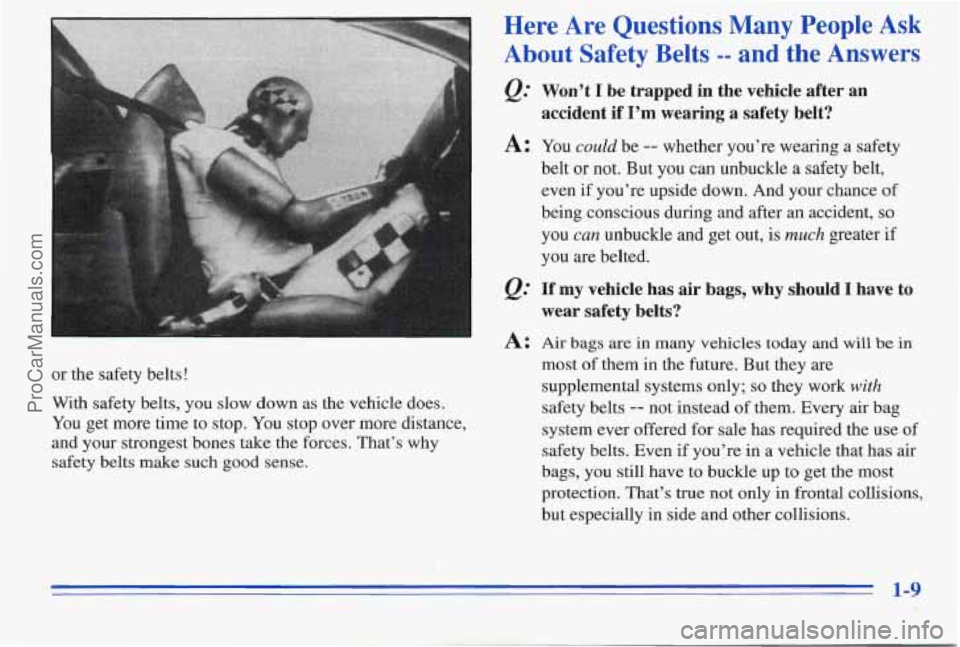
or the safety belts!
With safety belts, you slow down
as the vehicle does.
You get more time to stop. You stop over more distance,
and your strongest bones take the forces. That’s why
safety belts make such
good sense.
Here Are Questions Many People Ask
About Safety Belts -- and the Answers
Q: Won’t I be trapped in the vehicle after an
accident
if I’m wearing a safety belt?
A3 You could be -- whether you’re wearing a safety
belt or not. But you can unbuckle
a safety belt,
even if you’re upside down. And your chance
of
being conscious during and after an accident, so
you can unbuckle and get out, is much greater if
you
are belted.
Q: If my vehicle has air bags, why should I have to
wear safety belts?
At Air bags are in many vehicles today and will be in
most of them in the future. But they are
supplemental systems only; so they work with
safety belts -- not instead of them. Every air bag
system ever offered for sale has required
the use of
safety belts. Even if you’re in a vehicle that has air
bags, you still have to buckle
up to get the most
protection. That’s true
not only in frontal collisions,
but especially in side and other collisions.
1-9
ProCarManuals.com
Page 72 of 370
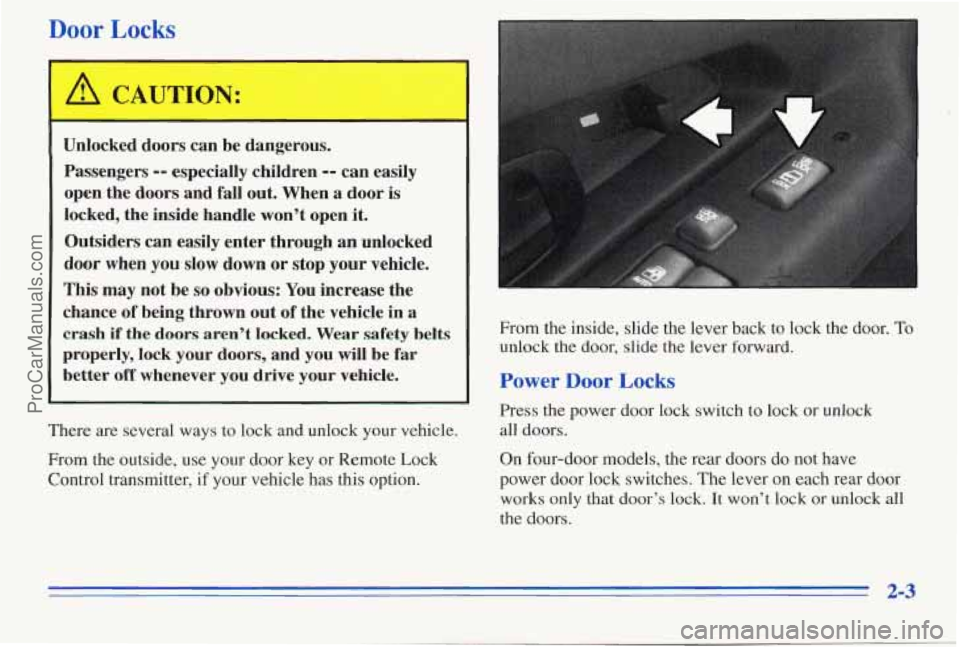
Door Locks
/1 CAUTION:
Unlocked doors can be dangerous.
Passengers
-- especially children -- can easily
open the doors and fall out. When a door is
locked, the inside handle won’t open it.
Outsiders can easily enter through an unlocked
door when you slow down
or stop your vehicle.
This may not be
so obvious: You increase the
chance
of being thrown out of the vehicle in a
crash if the doors aren’t locked. Wear safety belts
properly, lock your doors, and you
will be far
better
off whenever you drive your vehicle.
There are several ways to lock and unlock your vehicle.
From the outside, use your door key or Remote Lock
Control transmitter, if your vehicle has this option. From
the inside, slide the lever back to lock the door.
To
unlock the door, slide the lever forward.
Power Door Locks
Press the power door lock switch to lock or unlock
all doors.
On four-door models, the rear doors do not have
power door lock switches. The lever
on each rear door
works only that door’s lock. It won’t lock or unlock all
the doors.
ProCarManuals.com
Page 77 of 370
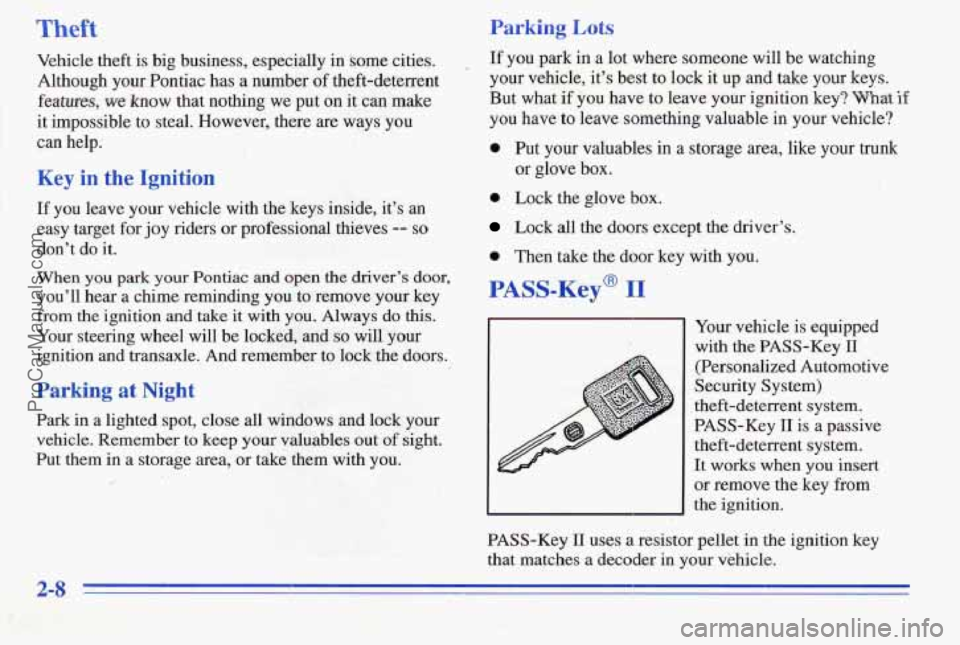
Theft
Vehicle theft is big business, especially in some cities.
Although your Pontiac has
a number of theft-deterrent
features, we know that nothing we put on it can make
it impossible to steal. However, there are ways you
can help.
Key in the Ignition
If you leave your vehicle with the keys inside, it’s an
easy target for joy riders or professional thieves
-- so
don’t do it.
When you park your Pontiac and open the driver’s door,
you’ll hear a chime reminding you to remove
your key
from
the ignition and take it with you. Always do this.
Your steering wheel will be locked, and so will your
ignition and transaxle., And remember to lock the doors.
Parking at Night
Park in a lighted spot, close all windows and lock your
vehicle. Remember
to keep your valuables out of sight.
Put them in
a storage area, or take them with you.
Parking Lots
If you park in a lot where someone will be watching
your vehicle, it’s best
to lock it up and take your keys.
But what if you have to leave your ignition
key? what if
you have to leave something valuable in your vehicle?
0 Put your valuables in a storage area, like your trunk
0 Lock the glove box.
Lock all the doors except the driver’s.
0 Then take the door key with you.
or
glove box.
PASS-Key@ I1
Your vehicle is equipped
with the PASS-Key
I1
(Personalized Automotive
Security System)
theft-deterrent system.
PASS-Key
I1 is a passive
tbeft-deterrent system.
It works when you insert
or remove the key from
the ignition.
I I I ”
PASS-Key 11 uses a resistor pellet in the ignition key
ProCarManuals.com
Page 102 of 370

Daytime Running Lamps (Option)
Daytime Running Lamps (DRL) can make it easier for
others to see the front
of your vehicle during the day.
DRL can be helpful in many different driving
conditions, but they can be especially helpful in the
short periods after dawn and before sunset.
A light sensor on top of the instrument panel makes the
DRL work, so be sure it isn’t covered.
The DRL system will make your low-beam headlamps
come on at a reduced brightness when:
0 The ignition is on,
0 The headlamp switch is off, and
0 The parking brake is released.
When
the DRL aye on, only your low-beam headlamps
will be on. The taillamps, sidemarker and other lamps
won’t be on.
Your instrument panel won’t be lit up either.
When it’s dark enough outside, your low-beam headlamps
will change to
full brightness. The other lamps that come
on with your headlamps will also
come on. When
it’s bright enough outside, the regular lamps will
go out, and your low-beam headlamps will change to
the reduced brightness of DRL.
To idle your vehicle with the DIU off, set the parking
brake while the ignition is in the
OFF or LOCK
position. Then start your vehicle. The DRL will stay
off until you release the parking brake.
As with any vehicle, you should turn on the regular
headlamp system when you need it.
Fog Lamps
To turn the fog lamps on, press the top of the fog lamp
switch
(C). Press the bottom of the switch to turn the fog
lamps
off. Your parking lamps must be on, or your fog
lamps won’t come on.
The fog lamps will
go off whenever you change to
high-beam headlamps. When you return to low beams,
the fog lamps will come on again.
. 2-33
ProCarManuals.com
Page 153 of 370

Understanding Radio Reception
FM stereo will give you the best sound. But FM signals
will reach only about
10 to 40 miles (16 to 65 h). Tall
buildings or hills can interfere with
FM signals, causing
the sound to come and
go..
AM
The range for mast tatians is greater than for FM,
especially at night. nger range, however, can
cause stations to in with each other. AM can pick
up noise from things'like storms and power lines. Try
reducing the treble to reduce this noise if you ever get it.
Tips About Your Audio System
Hearing damage from loud noise is almost undetectable
until it is too late. Your hearing can adapt to higher
volumes of sound. Sound
that seems normal can be loud
and harrrrful to your hearing Take precautions by
adjusting
the volume control on your radio to a safe
sound level before your hearing adapts to it.
To help avoid hearing loss or damage:
0 Adjust the volume control to the lowest setting.
Increase volume slowly until you hear comfortably
and clearly.
NOTICE:
Before you add any sound equipment to your
vehicle
-- like a tape player, CB radio, mobile
telephone
or two-way raclio -- be sure you can
add what you want. If you can, it's very important
to do it properly. Added sound equipment may
interfere with the operation of your vehicle's
engine, Delco radio or other systems, and even
damage them.
Your vehicle's systems may
interfere
with the operation of sound equipment
that
Ras been added'improperly.
So, before adding sound equipment, check with
your dealer and be sure to check Federal rules
covering mobile radio and telephone units. 1
3-22
ProCarManuals.com
Page 164 of 370
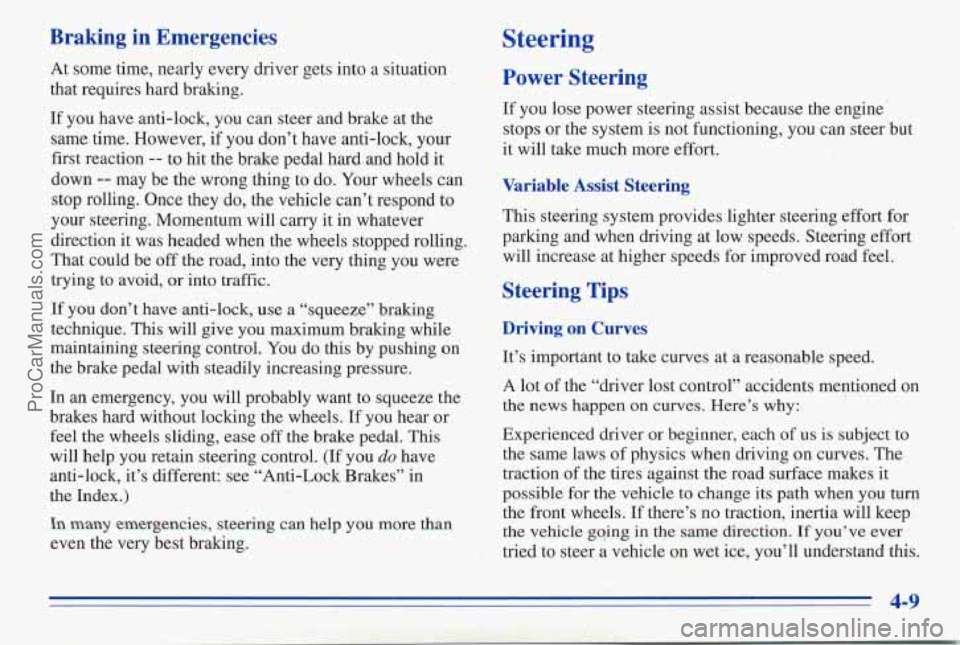
Braking in Emergencies
At some time, nearly every driver gets into a situation
that requires hard braking.
If you have anti-lock, you can steer and brake at the
same time. However,
if you don’t have anti-lock, your
first reaction
-- to hit the brake pedal hard and hold it
down
-- may be the wrong thing to do. Your wheels can
stop rolling. Once they do, the vehicle can’t respond to
your steering. Momentum will
carry it in whatever
direction it was headed when the wheels stopped rolling.
That could be off the road, into the very thing you were
trying to avoid, or into traffic.
If you don’t have anti-lock, use
a “squeeze” braking
technique.
This will give you maximum braking while
maintaining steering control. You do this by pushing on
the brake pedal with steadily increasing pressure.
In an emergency, you will probably want to squeeze the
brakes hard without locking the wheels. If you hear or
feel the wheels sliding, ease
off the brake pedal. This
will help you retain steering control. (If you
do have
anti-lock, it’s different: see “Anti-Lock Brakes” in
the Index.)
In many emergencies, steering can help you more than
even the very best braking.
Steering
Power Steering
If you lose power steering assist because the engine‘
stops or the system is not functioning, you can steer but
it will take much more effort.
Variable Assist Steering
This steering system provides lighter steering effort for
parking and when driving at low speeds. Steering effort
will increase at higher speeds for improved road feel.
Steering Tips
Driving on Curves
It’s important to take curves at a reasonable speed.
A lot of the “driver lost control” accidents mentioned on
the news happen on curves. Here’s why:
Experienced driver or beginner, each of us is subject to
the same laws
of physics when driving on curves. The
traction of the tires against the road surface makes it
possible for the vehicle to change its path when you turn
the front wheels. If there’s no traction, inertia will keep
the vehicle gqing in the same direction. If you’ve ever
. . ,,: ., .. %
A,. .c .. j: tried to steer a vehicle on wet ice, you’ll understand this.
ProCarManuals.com
Page 167 of 370
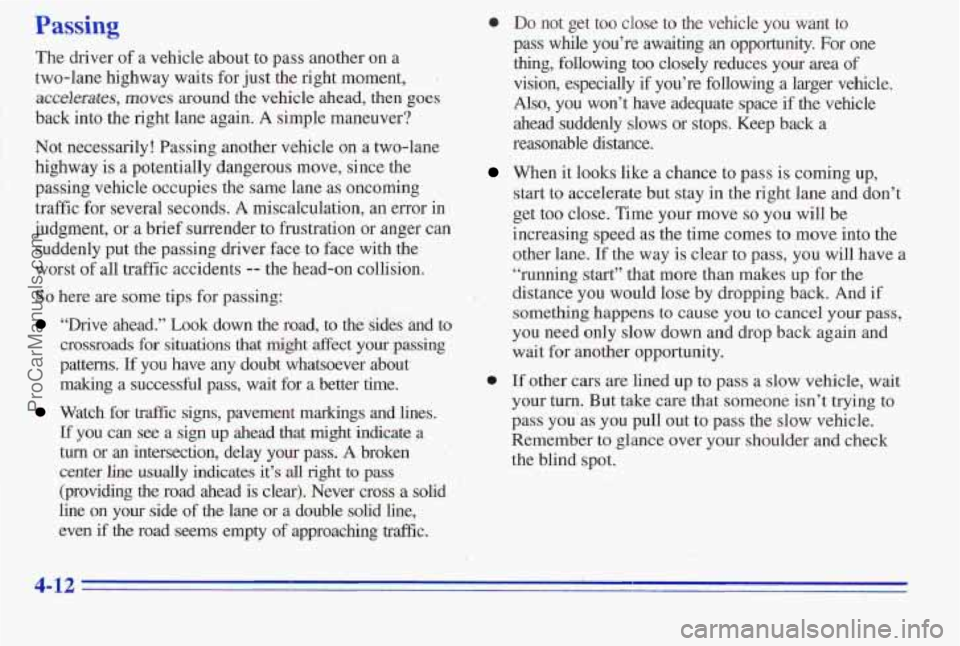
Passing
The driver of a vehicle about to pass another on a
two-lane highway waits for just the right moment,
.
accelerates, moves around the vehicle ahead, then goes
back into the right lane again.
A simple maneuver?
Not necessarily! Passing another vehicle on a two-lane
highway
is a potentially dangerous move, since the
passing vehicle occupies the same lane as oncoming
traffic for several seconds.
A miscalculation, an error in
judgment, or a brief surrender to frustration or anger can
suddenly put the passing driver face to face with the
worst of all traffic accidents
-- the head-on collision.
So here are some tips for passing:
“Drive ahead.” Look down the road, to the sides and to
crossroads
for situations that might affect your passing
patterns. If you have any doubt whatsoever about
making a successful pass, wait for
a better time.
Watch for traffic signs, pavement markings and lines.
If you can see a sign up ahead that might indicate a
turn or an intersection, delay your pass. A broken I
center line usually indicates it’s all right to pass
(providing the.road ahead is clear). Never cross
a solid
line on your side of the lane or a double solid line,
even if the road
seems empty of approaching traffic.
0 Do not get too close to the vehicle you want to
phs while you’re awaiting an opportunity. For one
thing, following too closely reduces your area of
vision, especially
if you’re following a larger vehicle.
Also, you won’t have adequate space if the vehicle
ahead suddenly slows or stops. Keep back a
reasonable distance.
When it looks like a chance to pass is coming up,
start to accelerate but stay in the right lane and don’t
get too close. Time your move
so you will be
increasing speed as the time comes to move into the
other lane.
If the way is clear to pass, you will have a
“running start” that more than makes up for
the
distance you would lose by dropping back. And if
something happens
to cause you to cancel your pass,
you need only slow down and drop back again and
wait for another opportunity.
e If other cars are lined up to pass a slow vehicle, wait
your turn. But take care that someone isn’t trying to
pass
you‘as you pull out to pass the slow vehicle.
Remember to glance over your shoulder
and check
the blind spot.
ProCarManuals.com
Page 168 of 370
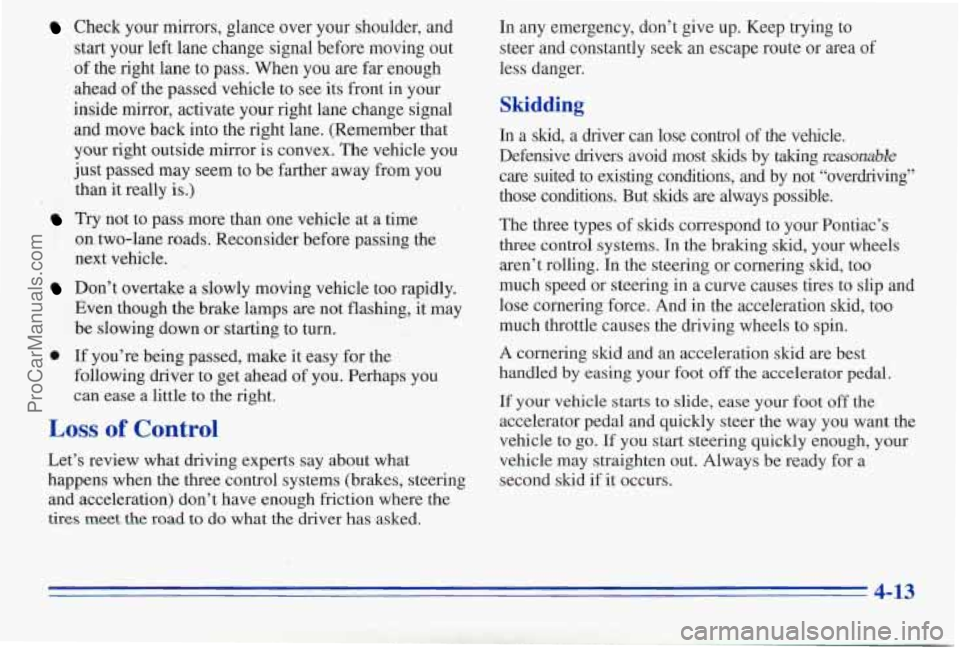
Check your mirrors, glance over your shoulder, and
start your left lane change signal before moving out
of the right lane to pass. When you are far enough
ahead of the passed vehicle to see its front in your
inside mirror, activate your right lane change signal
and move back into the right lane. (Remember that
your right outside mirror
is convex. The vehicle you
just passed may seem to be farther away from you
than it really
is.)
on two-lane roads. Reconsider before passing the
next vehicle.
Don’t overtake a slowly moving vehicle too rapidly.
Even though the brake lamps are not flashing, it may
be slowing down or starting to turn.
Try not to pass more than one vehicle at a time
0 If you’re being passed, make it easy for the
following driver to get ahead of you. Perhaps you
can ease a
little to the right.
Loss of Control
Let’s review what driving experts say about what
happens when the three control systems (brakes, steering
and acceleration) don’t have enough friction where
the
tires meet the road to do what the driver has asked. In
any emergency, don’t give up. Keep trying to
steer and constantly seek an escape route or area
ot
less danger.
Skidding
In a slud, a driver can lose control of the vehcle.
Defensive drivers avoid most skids by
taking reasonable
care suited to existing conditions, and by not “overdriving”\
those conditions. But skids
are always possible.
The three types of skids correspond to your Pontiac’s
three control systems.
In the braking skid, your wheels
aren’t rolling. In the steering or cornering skid, too
much speed or steering in a curve causes tires to slip and
lose cornering force. And in the acceleration skid, too
much throttle causes the driving wheels
to spin.
A cornering skid and an acceleration skid are best
handled by easing your foot
off the accelerator pedal.
If your vehicle starts to slide, ease your foot off the
accelerator pedal and quickly steer the way you want the
vehicle to go.
If you start steering quickly enough, your
vehicle may straighten out. Always be ready for a
second skid if it occurs.
ProCarManuals.com